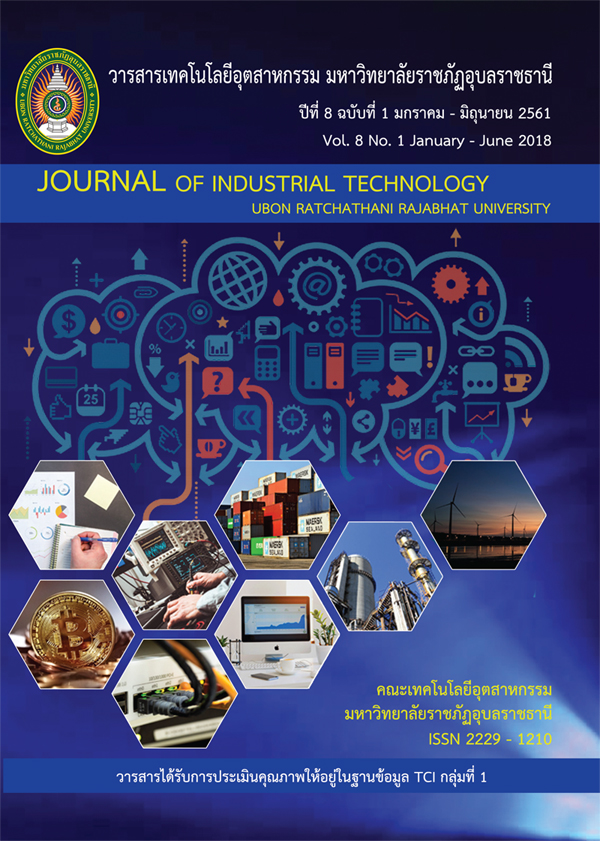การดูดซับทองแดงจากสารละลายสังเคราะห์คอปเปอร์ซิเตรท ที่ได้จากการสกัดขยะอิเล็กทรอนิกส์ด้วยกระบวนการสกัดทางชีวภาพ
Main Article Content
บทคัดย่อ
การวิจัยนี้มีวัตถุประสงค์ศึกษาการดูดซับทองแดงจากสารละลายสารประกอบเชิงซ้อนที่ได้จากการสกัดขยะอิเล็กทรอนิกส์ด้วยวิธีการสกัดทางชีวภาพ ด้วยคีเล็ตติ้งเรซินหมู่ฟังก์ชัน Bis (2-pyridylmethyl) amine-Dowex m4195 H-form การทดลองทั้งหมดอยู่ในรูปแบบกะ ศึกษาผลของพีเอชของสารละลายต่อประสิทธิภาพการดูดซับ ผลของเวลาต่อการดูดซับที่พีเอชแตกต่างกัน และผลของอุณหภูมิต่อการดูดซับที่อุณหภูมิแตกต่างกัน และนำผลที่ได้มาศึกษาจลนพลศาสตร์การดูดซับ พบว่าประสิทธิภาพการดูดซับขึ้นกับค่าพีเอชของสารละลาย การศึกษาจลนพลศาสตร์ของการดูดซับโดยใช้สมการปฏิกิริยาอันดับหนึ่งเทียมและปฏิกิริยาอันดับสองเทียมเพื่อคำนวณค่าคงที่อัตราการดูดซับ และศักยภาพในการดูดซับที่สภาวะสมดุล ด้วยวิธี Nonlinear Regression พบว่าจลนพลศาสตร์การดูดซับสอดคล้องกับสมการปฏิกิริยาอันดับสองเทียม ค่า k2มีแนวโน้มเพิ่มขึ้นเมื่อพีเอชของสารละลายของสารประกอบและอุณหภูมิของระบบทดสอบเพิ่มขึ้น ปริมาณการดูดซับสูงสุด (qmax) เท่ากับ 71.87 มิลลิกรัมต่อกรัมเรซิน ที่พีเอช 2-2.5 การศึกษาการคายซับ พบว่ากรดซัลฟูริก 2 โมลาร์ สามารถคายซับทองแดงได้ดีกว่า กรดไฮโดรคลอริก ประสิทธิภาพการคายซับเท่ากับ 52 เปอร์เซ็นต์ คิดเป็น 31.25 มิลลิกรัมต่อกรัมเรซิน เรซิน Dow m4195 มีความเหมาะสมในการนำทองแดงออกจากขยะอิเล็กทรอนิกส์
Article Details
บทความที่ได้รับการตีพิมพ์ในวารสารฯ ท้ังในรูปแบบของรูปเล่มและอิเล็กทรอนิกส์เป็นลิขสิทธิ์ของวารสารฯ
เอกสารอ้างอิง
[2] Widmer R, Oswald-Krapf H, Sinha-Khetriwal D, Schnellmann M, Boni H. Global Perspectives on E-Waste. Environmental Impact Assessment Review. 2005; 25(5): 436–58.
[3] Hong Y, Valix M. Bioleaching of electronic waste using acidophilic sulfur oxidising bacteria. Journal of Cleaner Production. 2014; 65: 465–72
[4] Bosecker K. Bioleaching: metal solubilization by microorganisms. FEMS Microbiology Reviews. 1997 ; 20(3–4) : 591–604.
[5] Chenglong Z, Yujia C, Jingwei W, Jianfeng B, Yuan Z, Wenjie W, et al. Recovery of copper from bio-leaching solutions of waste printed circuit boards waste by ion exchange. IEEE Computer Science Society: 2010 International Conference on Digital Manufacturing and Automation (ICDMA). doi: 10.1109/ICDMA.2010.428
[6] Valix M. Bioleaching of Electronic Waste: Milestones and Challenges. Current Developments in Biotechnology and Bioengineering: Solid Waste Management. 2017; p. 407-42.
[7] Saidan M, Brown B, Valix M. Leaching of electronic waste using biometabolised acids. Chinese Journal of Chemical Engineering. 2012; 20(3): 530–4.
[8] Deepatana A, Valix M. Recovery of nickel and cobalt from organic acid complexes: Adsorption mechanisms of metal-organic complexes onto aminophosphonate chelating resin. Journal of Hazardous Materail. 2006 (B137): 925-33.
[9] Deepatana A, Valix A. Comparative adsorption isotherms and modeling of nickel and cobalt citrate complexes onto chelating resins. Desalination.2008; 218: 334-42.
[10] Dow Chemical Company. Ion Exchange Resins for Industrial Water Treatment Product Summary Table [internet]. 2018. Available from: www.dow.com/scripts/litorder.asp?filepath=liquidseps/
pdfs/noreg/
[11] Diniz CV, Ciminelli VST, Doyle FM. The use of the chelating resin Dowex M-4195 in the adsorption of selected heavy metal ions from manganese solutions. Hydrometallurgy. 2005; 78(3) : 147–55.
[12] Georgiev P, Groudev SN, Spasova I, Nicolova M, Mihaylova K, Karamfilov D. Desorption of copper from loaded ion-exchange resin Lewatit as a stage of processing of copper bioleaching solutions. Aannual of the university of mining and geology “ST IVAN RILSKI”. 2014; 57; 120–5.
[13] Brandl H, Bosshard R, Wegmann M. Computer-munching microbes: metal leaching from electronic scrap by bacteria and fungi. Hydrometallurgy. 2001; 59(2): 319–26.
[14] Boparai HK, Joseph M, O’Carroll DM. Kinetics and thermodynamics of cadmium ion removal by adsorption onto nano zerovalent iron particles. Journal of Hazardous Material. 2011; 186(1): 458–65.
[15] Shirvani M, Shariatmadari H, Kalbasi M. Kinetics of cadmium desorption from fibrous silicate clay minerals: Influence of organic ligands and aging. Applied Clay Science. 2007; 37(1–2): 175–84.
[16] Gao J, Liu F, Ling P, Lei J, Li L, Li C, et al. High efficient removal of Cu (II) by a chelating resin from strong acidic solutions: Complex formation and DFT certification. Chemical Engineering Journal. 2013; 222: 240–7.
[17] Mendes FD, Martins AH. Selective sorption of nickel and cobalt from sulphate solutions using chelating resins. International Journal of Mineral Processing. 2004; 74(1–4): 359–71.
[18] Dahri MK, Kooh MRR, Lim LBL. Application of Casuarina equisetifolia needle for the removal of methylene blue and malachite green dyes from aqueous solution. Alexandria Engineering Journal. 2015; 54(4): 1253–63.
[19] Pamukoglu Y. Removal of heavy metals from wase water by biosorption using excess slugde [dissertation of Doctor of Philosophy]. Izmir, Turkey: Dokuz Eylül University; 2008.
[20] Şengil İA, Özacar M. Competitive biosorption of Pb2+, Cu2+ and Zn 2+ ions from aqueous solutions onto valonia tannin resin. Journal of Hazardous Material. 2009; 166(2): 1488–94.
[21] Kolodynska D. Chelating agents of a new generation as an alternative to conventional chelators for heavy metal ions removal from different waste waters. Lubin, Poland: Maria Curie Sklodowska University; 2011.
[22] Franz M. Phosphate fertilizer from sewage sludge ash (SSA). Waste Management. 2008; 28(10): 1809–18.


